Picture this: A women’s basketball player steps to the free-throw line in the fourth quarter. The gymnasium falls silent. She sinks both shots, and suddenly the crowd erupts—she’s just become the newest member of her school’s 1,000 point club. Within minutes, her achievement spreads across social media. Within hours, her school presents her with a custom basketball commemorating the milestone. And within seconds, her accomplishment appears on the school’s digital touchscreen recognition display, where it will inspire athletes for years to come.
This scenario plays out in high schools and colleges across the country each season, yet many schools struggle to give these achievements the lasting recognition they deserve. Traditional approaches—paper certificates, dusty trophy cases, forgotten newspaper clippings—fail to capture the significance of joining basketball’s most exclusive club. The 1,000 point milestone deserves better.

The Significance of the 1,000 Point Milestone
Scoring 1,000 points in a high school or college basketball career is exceptionally rare. The achievement requires a unique combination of skill, longevity, health, opportunity, and consistent performance across multiple seasons.
What Makes 1,000 Points So Special?
Sustained Excellence Over Years: Unlike single-game achievements or even season-long accomplishments, reaching 1,000 points requires excellence sustained across an entire athletic career. Most athletes play three to four varsity seasons, meaning they must average 250-333 points per season to reach this milestone. That translates to roughly 10-15 points per game consistently across years—a level of performance few athletes maintain.
Overcoming Adversity: The path to 1,000 points inevitably includes obstacles. Injuries that sideline players for games or entire seasons. Shooting slumps that test mental resilience. Team role changes requiring adjustment. Defensive schemes specifically designed to limit scoring. Athletes who reach 1,000 points have demonstrated not just skill but the character to persevere through setbacks.
Team Success Alongside Individual Achievement: While the 1,000 point milestone celebrates individual accomplishment, it typically reflects positive team performance. Players on successful teams generally have more scoring opportunities. The best 1,000 point scorers balance personal achievement with team success, elevating teammates while reaching individual milestones.
Historical Context: When athletes join their school’s 1,000 point club, they enter a select group spanning decades of program history. Depending on program size and history, schools might have fewer than 20 total members across all basketball history. This exclusivity makes the achievement even more meaningful.

Statistical Rarity of 1,000 Point Scorers
While exact statistics vary by school size and competitive level, reaching 1,000 points remains exceptional across all contexts. Consider the mathematics: If a high school has 200 students per grade level, perhaps 15-20 students try out for basketball, and maybe 10-12 make the varsity team. Of those 10-12 players, typically only 1-2 might eventually reach 1,000 career points—less than 1% of the entire student body.
At the college level, the achievement becomes even rarer. With four years of eligibility, reaching 1,000 points still requires averaging 250 points per season—impressive considering reduced playing time for underclassmen, stronger competition, and the challenges of balancing athletics with demanding academic schedules.
Traditional Recognition Approaches and Their Limitations
For decades, schools have recognized 1,000 point scorers through established methods that, while meaningful, fail to provide the visibility and lasting impact these achievements deserve.
Common Recognition Methods
Printed Certificates and Plaques: The most common approach involves presenting athletes with certificates or small plaques acknowledging their 1,000 point achievement. While tangible and personal, these items typically end up stored in bedroom closets or parents’ homes, invisible to current students who might be inspired by these accomplishments.
Trophy Case Displays: Many schools add names or small plaques to trophy cases listing 1,000 point scorers. However, trophy cases face significant limitations:
- Physical space constraints limit how much information can be displayed
- Static displays can’t include photos, videos, or detailed statistics
- Cluttered arrangements make individual achievements less visible
- Updates require removing and replacing physical materials
- Deterioration over time diminishes the honor of recognition
Recognition at Games or Ceremonies: Schools often recognize 1,000 point scorers during halftime ceremonies or end-of-season banquets. These moments provide valuable immediate celebration but lack permanence. Current underclassmen who might be inspired by the achievement may not attend these events, and within weeks, the moment fades from collective memory.
Custom Basketballs: Presenting athletes with game balls or special basketballs commemorating their 1,000th point creates meaningful keepsakes. However, like certificates and plaques, these items typically remain with the individual athlete rather than inspiring broader school communities.
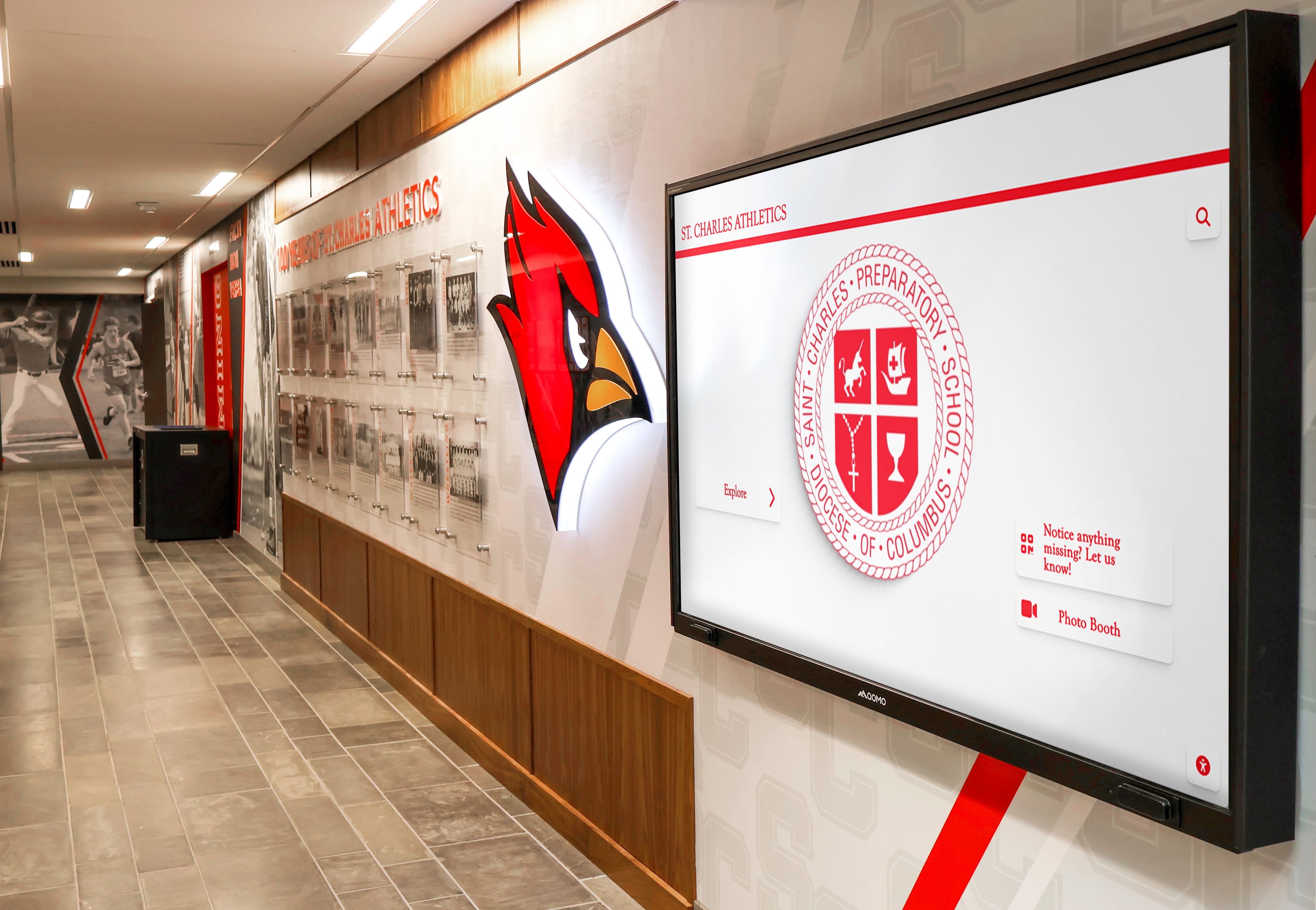
Why Traditional Approaches Fall Short
Traditional recognition methods suffer from three fundamental limitations:
Limited Visibility: Recognition confined to trophy cases, ceremonies, or personal keepsakes reaches small audiences. Underclassmen who could be inspired to chase similar milestones may never learn about recent 1,000 point scorers. Visiting opponents, prospective students, and community members miss opportunities to appreciate program excellence.
Lack of Context and Story: Names on plaques communicate bare facts—who scored 1,000 points and when—but miss opportunities to tell the complete story. What challenges did they overcome? How did their game evolve across seasons? What made their achievement unique? Traditional displays rarely capture the narrative depth that makes achievements truly inspiring.
Difficult to Maintain and Update: Physical recognition systems require manual labor for every update. Adding new 1,000 point scorers means purchasing new materials, updating displays, and ensuring consistency with existing recognition. Schools often delay updates due to these logistical barriers, diminishing the timeliness and impact of recognition.
The Digital Revolution in Athletic Recognition
Modern digital recognition displays solve the limitations of traditional approaches while creating engaging, comprehensive celebration systems that benefit entire school communities. Solutions like Rocket Alumni Solutions provide purpose-built platforms specifically designed for athletic recognition.
What Are Digital Recognition Displays?
Digital recognition displays combine commercial-grade touchscreen hardware with specialized software designed for athletic achievement celebration. Unlike generic digital signage, these systems offer interactive experiences where visitors can explore athletic history, search for specific athletes or achievements, and engage with rich multimedia content including photos, videos, and detailed statistics.
The most effective systems integrate with existing school record-keeping, making updates as simple as entering new data through web-based content management systems. When a student athlete hits 1,000 points, athletic directors or coaches can add comprehensive recognition to the digital display in minutes—no printing, no physical installation, no waiting for materials.
Key Advantages of Digital Recognition
Unlimited Capacity: Physical space no longer constrains recognition. Digital displays can house profiles for every 1,000 point scorer in program history, from the first player to achieve the milestone decades ago to the athlete who joined the club last week. Each receives equal prominence with comprehensive profile space impossible in physical trophy cases.
Rich Multimedia Storytelling: Digital platforms transform basic recognition into compelling stories. Each 1,000 point scorer profile can include:
- Professional photographs from their playing career
- Video highlights of memorable performances
- Career statistics and season-by-season progression
- Quotes from the athlete about their experience
- Information about college recruitment and future plans
- Follow-up content about their athletic and life success after graduation
This depth creates emotional connections and provides inspirational context that static plaques cannot match.
Instant, Real-Time Updates: When an athlete scores their 1,000th point, recognition can appear on digital displays immediately. No waiting weeks or months for materials to arrive or installation to happen. The ability to provide timely recognition while excitement remains high dramatically increases impact and demonstrates that schools genuinely value these achievements.
Interactive Exploration: Touchscreen interfaces allow visitors to explore athletic achievement on their own terms. Freshmen wondering if reaching 1,000 points is possible can search for players from similar positions or heights. Alumni returning to campus can find their own profiles and see how the program has evolved. Parents and visiting college coaches can browse comprehensive program histories.
This interactivity increases engagement time and creates memorable experiences that passive viewing of trophy cases cannot provide.

Integration with Broader Recognition Systems
The most effective digital recognition goes beyond isolated 1,000 point displays to integrate comprehensive athletic achievement celebration. Modern systems connect individual milestones like 1,000 point scorers with:
- Team championships and tournament successes
- Season and career statistical records
- College commitment celebrations
- All-conference and all-state honors
- Academic achievement recognition
This comprehensive approach ensures all forms of excellence receive appropriate visibility while creating complete pictures of individual athlete journeys and overall program success. Digital record boards specifically designed for basketball provide templates optimized for displaying scoring milestones alongside other achievements.
Creating Meaningful Recognition Experiences
Simply having a digital display isn’t enough—schools must thoughtfully design recognition content that truly honors achievement while inspiring current and future athletes.
Essential Elements of 1,000 Point Scorer Profiles
Professional Photography: High-quality photographs communicate that achievements matter. Invest in professional or semi-professional photography rather than relying on smartphone snapshots. Capture action shots during games showing athletes’ playing styles, as well as posed portraits in uniform. Consider including multiple photos showing athletes at different points in their careers to illustrate development.
Comprehensive Statistics: Context helps audiences appreciate achievement magnitude. Include:
- Career point total and class standing among program 1,000 point scorers
- Points per game average across career
- Season-by-season scoring progression
- Game where 1,000th point occurred with opponent and date
- Other statistical accomplishments (rebounds, assists, etc.)
- Team records and championships during their career
Personal Narratives: The numbers tell part of the story, but personal insights create emotional connections. Include quotes from:
- The athlete discussing what reaching 1,000 points means
- Coaches describing the athlete’s development and character
- Teammates acknowledging their impact
- Parents reflecting on the journey
- Follow-up comments years later about how the experience shaped them
Achievement Context: Help audiences understand what the milestone required. Mention:
- Challenges overcome (injuries, position changes, etc.)
- Notable games or performances
- Development arc from freshman to senior
- How they balanced scoring with team play
- Work ethic and preparation that enabled success
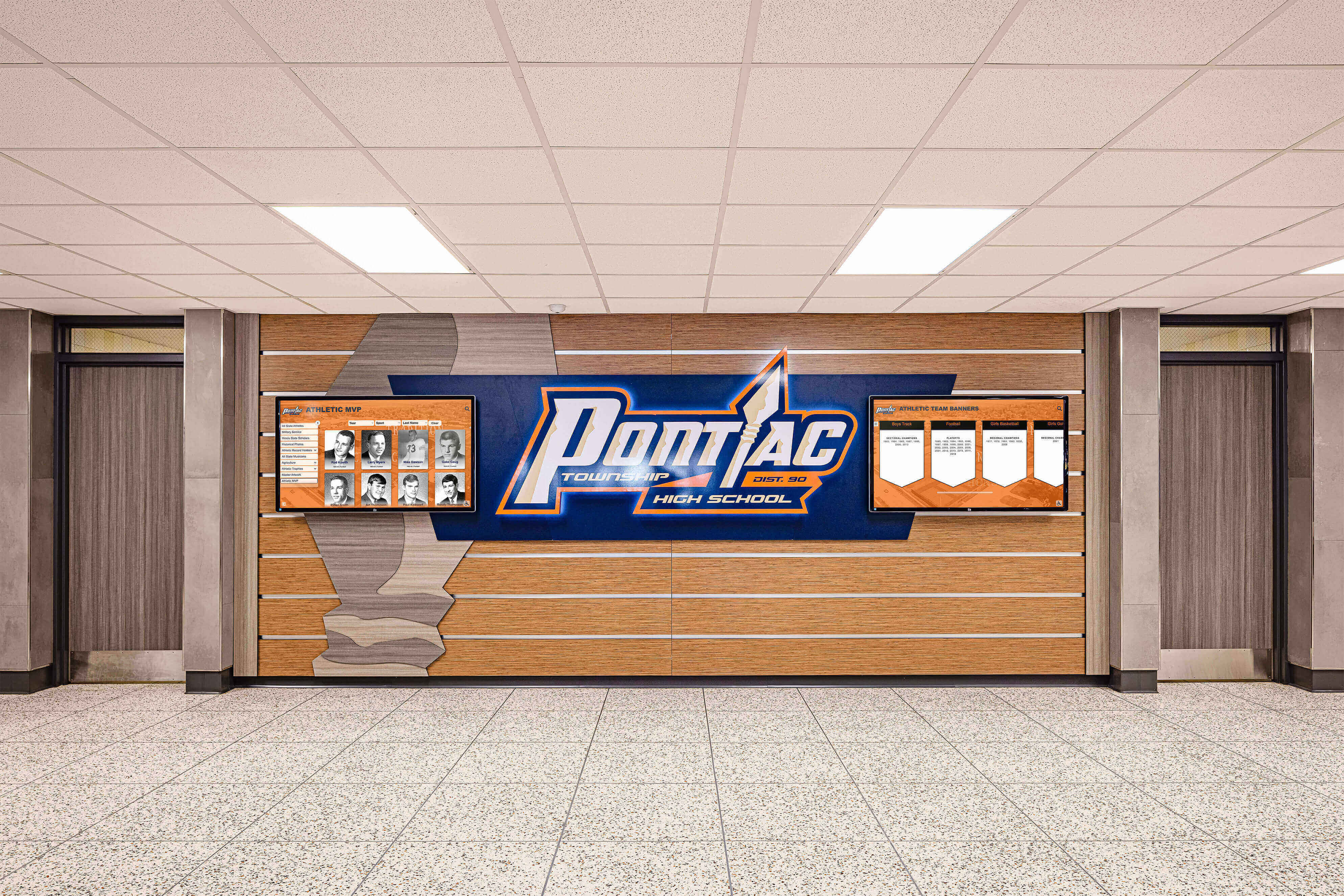
Ceremony and Presentation Best Practices
Digital recognition shouldn’t replace personal celebration but rather complement and extend it. The most effective recognition programs combine meaningful in-person ceremonies with lasting digital commemoration.
Timing the Ceremony: When possible, plan recognition ceremonies for games following the milestone achievement. This allows proper preparation while maintaining excitement and relevance. Schedule ceremonies at natural breaks—halftime or before games—when maximum audiences are present and attentive.
Custom Presentation Materials: The custom basketball mentioned in your scenario represents an excellent tangible recognition element. Consider additional presentation materials:
- Framed certificates or plaques for personal keepsakes
- Highlight videos shown during the ceremony
- Programs or commemorative materials for attendees
- Social media graphics families can share
Inclusive Celebration: Involve the broader community in celebration:
- Invite family members onto the court during recognition
- Include youth basketball program members who look up to high school athletes
- Encourage teammates to participate in acknowledgment
- Provide opportunities for community members to congratulate the athlete
Digital Display Unveiling: Make adding the athlete’s profile to the digital recognition display part of the ceremony. Walk to the touchscreen, input the profile, and invite the athlete to be the first to interact with their digital recognition. This creates a powerful moment connecting traditional ceremony with modern commemoration.
Leveraging Social Media and Extended Recognition
Digital recognition displays provide excellent content for social media amplification, extending recognition reach far beyond those physically present.
Social Media Strategy: When athletes reach 1,000 points, coordinate recognition across multiple platforms:
- Instagram posts featuring highlight photos with career statistics
- Twitter/X announcements tagging the athlete and celebrating the milestone
- Facebook longer-form posts with career narratives
- TikTok highlight compilations set to music
- YouTube videos of the 1,000th point and recognition ceremony
Include links or QR codes directing followers to the full digital profile on the school’s recognition display, driving engagement with the comprehensive content.
Local Media Outreach: Provide local media outlets with press releases, statistics, photos, and access to digital profiles. Making journalists’ jobs easier increases coverage likelihood, amplifying recognition throughout the broader community. Athletic achievement stories remain popular content for local newspapers and sports websites.
Alumni Engagement: Share 1,000 point milestone achievements with alumni associations and networks. Former athletes appreciate seeing their records honored alongside new achievers. This maintains alumni connection and often generates support for athletic programs through donations or volunteer mentoring.
Implementation: Bringing Digital Recognition to Your Program
Schools interested in modernizing athletic recognition should approach implementation strategically to ensure sustainable, effective systems that serve communities for decades.
Assessing Needs and Goals
Stakeholder Input: Before selecting systems or designing content, gather input from multiple perspectives:
- Athletic directors understanding program-wide needs
- Coaches knowing athlete and team recognition priorities
- Current athletes describing what would be meaningful to them
- Parents offering perspectives on family engagement
- Alumni sharing what would strengthen their continued connection
- Technology staff assessing technical requirements and support capabilities
This diverse input ensures solutions meet actual needs rather than assuming preferences.
Historical Content Planning: Determine how far back recognition should extend. Some schools choose to digitize complete athletic histories, researching and creating profiles for 1,000 point scorers from decades past. Others begin with recent achievers and add historical content over time. Consider:
- Availability of historical statistics and photos
- Alumni who might assist with historical research
- Resources available for content creation
- Whether partial historical coverage creates equity concerns
Budget and Funding: Digital recognition systems require financial investment, though long-term costs often prove lower than ongoing physical trophy case maintenance. Budget considerations include:
- Initial hardware costs (touchscreen displays and mounting systems)
- Software licensing (ongoing subscriptions vs. one-time purchases)
- Content creation resources (photography, videography, writing)
- Installation and technical support
- Ongoing maintenance and updates
Explore funding sources including booster club support, alumni donations, corporate sponsorships, and grant opportunities from education or sports foundations.

Selecting Technology Solutions
Hardware Considerations: Touchscreen displays come in various sizes and configurations:
- Screen size (typically 43-75 inches for lobby installations)
- Resolution (4K recommended for sharp text and image quality)
- Touch technology (capacitive vs. infrared vs. acoustic)
- Mounting options (wall-mounted vs. freestanding kiosks)
- Durability ratings for high-traffic athletic facility environments
Work with vendors experienced in educational installations who understand the unique requirements of school athletic facilities. Comprehensive hardware selection guides can help navigate options.
Software Capabilities: Recognition software should offer:
- Intuitive content management systems for non-technical staff
- Flexible templates designed specifically for athletic recognition
- Multimedia support for photos, videos, and documents
- Search and filtering functionality for easy navigation
- Mobile-responsive web versions extending access beyond physical displays
- Analytics tracking engagement and popular content
- Regular updates and vendor support
Specialized platforms designed for school recognition, like those from Rocket Alumni Solutions, provide turnkey solutions optimized for these specific needs. General-purpose digital signage software often requires significant customization to work well for athletic recognition.
Installation and Support: Professional installation ensures optimal performance and longevity. Consider:
- Electrical requirements and power access
- Network connectivity (hardwired Ethernet strongly preferred over WiFi)
- Mounting locations with good visibility and accessibility
- Protection from potential damage in high-activity areas
- Ongoing technical support availability
- Staff training on content management
Content Development Workflows
Establishing Processes: Successful digital recognition requires sustainable workflows for creating and maintaining content. Define:
- Who captures photos during games and events
- How statistics are collected and verified
- Who writes profile narratives and gathers quotes
- Content approval processes before publication
- Timeline expectations (profiles added within X days of achievements)
- Historical content research and creation responsibilities
Photography Standards: Consistent, high-quality photography dramatically improves recognition display professionalism. Establish guidelines for:
- Image resolution and dimensions
- Preferred angles and compositions
- Lighting and exposure standards
- Action shots vs. portraits
- Uniform and branding consistency
- File naming and organization conventions
Writing Guidelines: Create style guides ensuring consistent, appropriate content across all athlete profiles. Specify:
- Tone and voice (celebratory but professional)
- Length recommendations for different content sections
- Statistical formatting standards
- Quote attribution practices
- Appropriate acknowledgment of challenges while remaining positive
Update Schedules: Determine when and how digital displays receive updates:
- Immediate updates for milestone achievements
- Weekly updates during active seasons
- End-of-season comprehensive additions
- Summer research and historical content development
- Annual content reviews ensuring accuracy and completeness
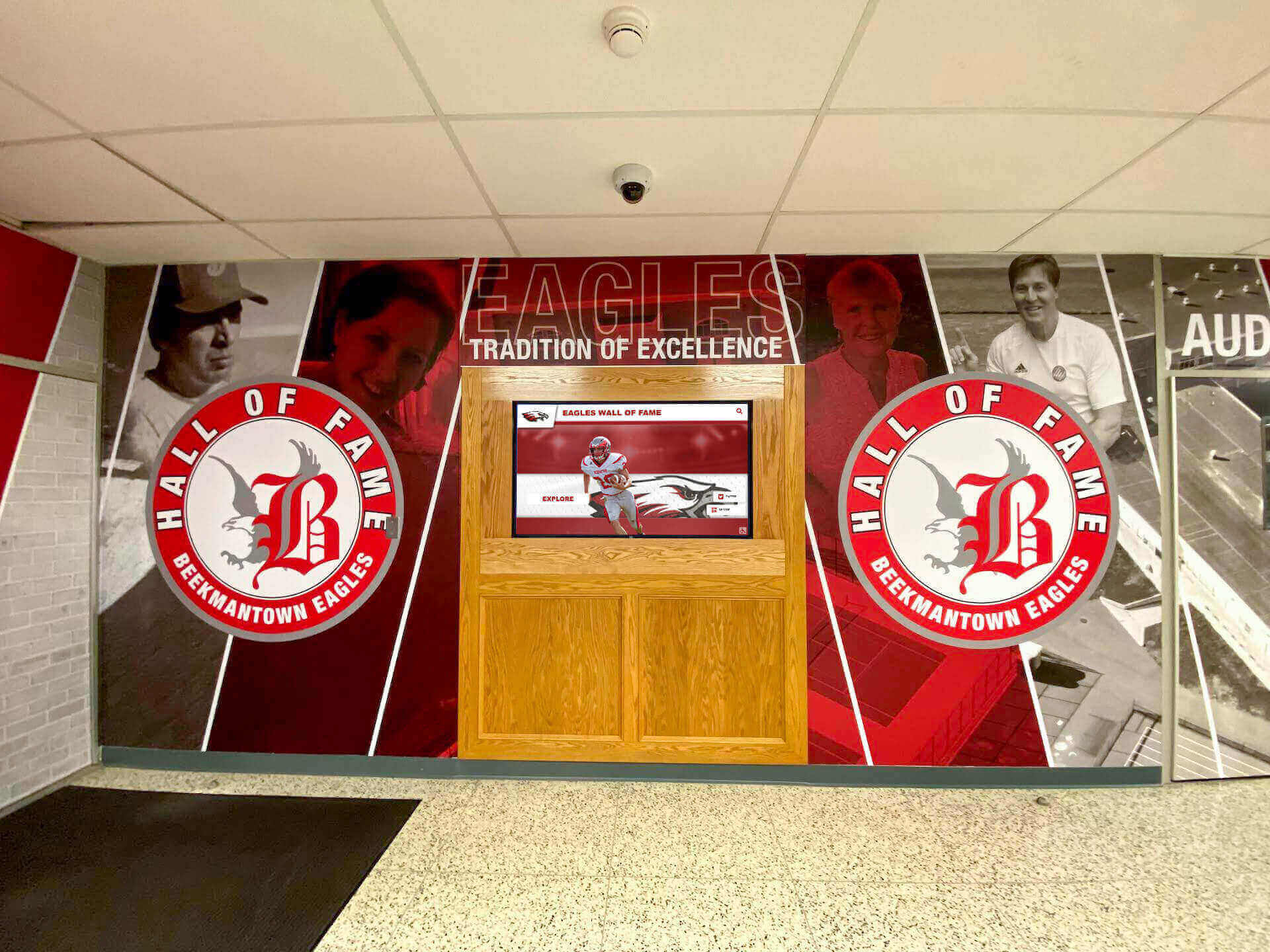
Inspiring the Next Generation of 1,000 Point Scorers
Perhaps the most valuable benefit of comprehensive digital recognition is inspiration. When underclassmen see detailed profiles of athletes who reached 1,000 points, abstract goals become tangible possibilities.
Creating Motivational Impact
Relatable Role Models: Digital recognition allows underclassmen to find athletes similar to themselves:
- Players from the same position
- Athletes with comparable physical attributes
- Students who balanced sports with similar academic demands
- Those who overcame similar challenges
This relatability transforms admiration into actionable belief: “If they did it, maybe I can too.”
Transparent Pathways: Detailed profiles illustrate the actual paths to 1,000 points. When freshmen see season-by-season progression showing how athletes developed their games, improved their statistics, and steadily accumulated points, the milestone seems achievable rather than impossibly distant.
Character Development: Profiles that acknowledge challenges and describe the work ethic required to reach 1,000 points teach valuable lessons about persistence, dedication, and delayed gratification. These character lessons may ultimately prove more valuable than athletic achievement itself.
Team Culture Building: When schools consistently recognize and celebrate individual achievement within team contexts, they create cultures valuing both personal excellence and collective success. Digital displays showcasing diverse achievements—1,000 point scorers alongside championship teams, academic honors, and community service—communicate that the program celebrates all dimensions of excellence.
Goal Setting and Tracking
Modern digital systems can provide goal-tracking functionality helping athletes pursue milestones:
- Current point totals and pace toward 1,000
- Historical comparison with past 1,000 point scorers at similar career stages
- Projection models showing points needed per remaining games
- Recognition of incremental progress (100, 250, 500, 750 points)
These tools transform distant goals into manageable milestones while maintaining motivation throughout multi-year athletic careers. Schools implementing comprehensive sports record-keeping systems create frameworks where athletes can track progress toward various achievements.
Beyond Basketball: Recognizing Diverse Athletic Excellence
While 1,000 point scoring represents a prestigious basketball milestone, comprehensive digital recognition celebrates achievement across all sports and contexts. The same principles and technologies that honor basketball excellence apply broadly.
Sport-Specific Milestones
Every sport has signature achievements deserving comparable recognition:
Football: Touchdown passes, rushing yards, total tackles, interceptions Baseball/Softball: Career hits, home runs, strikeouts (pitchers), wins (pitchers) Soccer: Goals scored, assists, shutouts (goalkeepers) Track and Field: School records in various events, state qualifications Swimming: Record times, state championship medals Wrestling: Career wins, tournament championships Volleyball: Career kills, assists, digs Tennis: Match wins, tournament championships
Digital platforms provide flexibility to celebrate sport-specific milestones using templates optimized for each sport’s unique achievement structure. Comprehensive systems might include football record boards, swimming achievement displays, and recognition across all athletic programs.
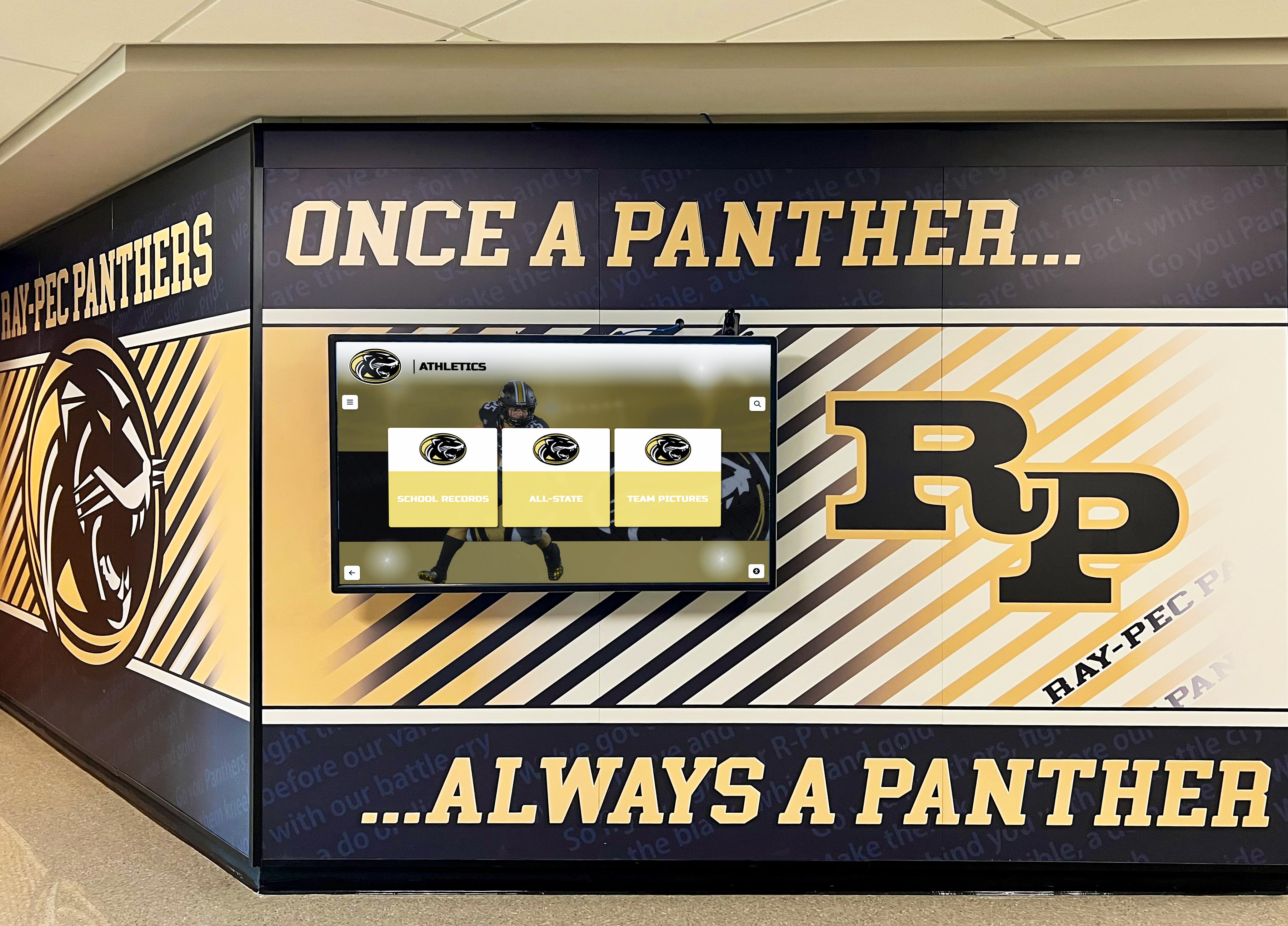
Academic and Character Recognition
The most effective school recognition extends beyond athletics to celebrate diverse excellence:
Academic Achievements: National Merit Scholars, academic competition winners, perfect attendance, dramatic academic improvement Arts Excellence: Theater performances, musical accomplishments, visual arts recognition Service Leadership: Community service hours, volunteer program leadership, character awards Career Preparation: Internship accomplishments, career certification achievements
When digital recognition platforms integrate athletic, academic, and character celebration, they communicate institutional values comprehensively while ensuring all students see pathways to recognition regardless of their particular talents.
Measuring Success: Recognition Program Impact
How do schools know if digital recognition investments are working? Effective evaluation considers multiple success indicators.
Quantitative Metrics
Engagement Analytics: Modern recognition platforms provide detailed usage data:
- Number of interactions with digital displays
- Time spent exploring content
- Most-viewed athlete profiles
- Search queries revealing interest areas
- Peak engagement times and patterns
Growing engagement over time indicates increasing community interest and validates investment in recognition systems.
Participation Trends: Monitor whether athletic participation and achievement patterns change following recognition program implementation:
- Tryout numbers for various sports
- Number of athletes reaching milestone achievements
- Improved performance metrics across programs
- Increased multi-season athlete retention
While multiple factors influence these trends, sustained improvement following recognition program launches suggests positive impact.
Social Media Amplification: Track digital reach of recognition content:
- Social media engagement metrics (likes, shares, comments)
- Website traffic to athletic recognition pages
- Local media coverage of achievements
- Alumni engagement with athletic content
Broader reach multiplies recognition impact beyond those physically visiting campus.
Qualitative Indicators
Athlete Perspectives: Regular feedback from athletes provides crucial insights:
- How meaningful they find recognition
- Whether digital profiles accurately represent their achievements
- Ideas for improving recognition experiences
- Impact on their sense of belonging and pride
Anonymous surveys may elicit more honest feedback than face-to-face conversations with administrators.
Family and Community Response: Gauge broader community reception:
- Comments from families during recognition ceremonies
- Alumni reflections on their own experiences being recognized
- Community members’ feedback on facility visits
- Recruitment appeal for prospective students and athletes
Program Culture Observations: The most important impacts may be cultural shifts that are difficult to quantify:
- Do athletes seem more motivated to pursue milestones?
- Has positive competition replaced negative jealousy?
- Do teammates genuinely celebrate individual achievements?
- Has the community’s perception of the athletic program improved?
- Do current athletes express pride in program traditions?
These qualitative observations, gathered through regular interaction with programs, often reveal the most significant benefits of comprehensive recognition systems.
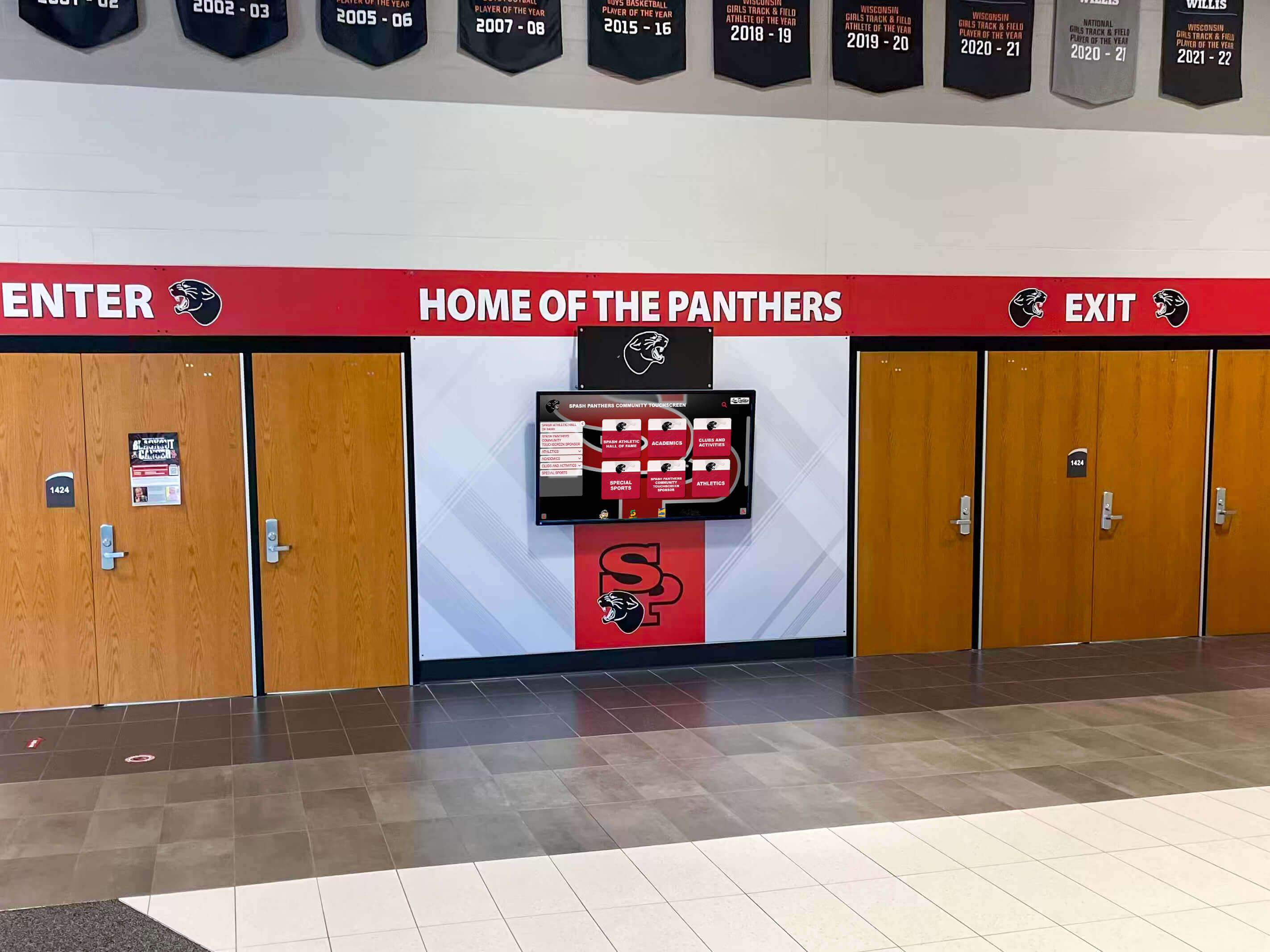
Future Trends in Athletic Recognition
Digital recognition technology continues evolving, creating new possibilities for celebrating achievement.
Emerging Capabilities
Artificial Intelligence Integration: AI may eventually enable:
- Automated highlight video creation from game footage
- Natural language search allowing conversational queries
- Personalized content recommendations based on viewing history
- Predictive analytics forecasting when athletes might reach milestones
Enhanced Interactivity: Next-generation displays might incorporate:
- Gesture control for touchless interaction
- Voice commands for accessibility and convenience
- Augmented reality overlays providing additional context
- Integration with personal devices for shared experiences
Social Connectivity: Future systems could facilitate:
- Direct athlete-to-fan interaction through moderated messaging
- Alumni mentoring connections between current and former athletes
- Virtual watch parties celebrating milestone achievements
- Crowdsourced content contribution from community members
Schools investing in modern recognition platforms today position themselves to adopt emerging capabilities as they mature, future-proofing athletic celebration systems.
Expanding Recognition Scope
Holistic Athlete Profiles: Future recognition may expand to celebrate complete athletic journeys:
- Physical development and training progression
- Mental skills and character growth
- Academic achievement alongside athletic success
- Post-graduation athletic and life accomplishments
- Contribution to teams and communities
Real-Time Integration: Live game statistics might feed directly into recognition displays:
- Point totals updating during games
- Milestone alerts when achievements occur
- Real-time celebration building school pride
Global Connection: Digital platforms could eventually connect:
- Athletic achievement across schools for broader context
- International perspective on similar milestones
- Multi-generational family athletic legacies
- Alumni networks spanning decades and locations
Conclusion: Honoring Excellence Through Modern Recognition
When a student athlete scores their 1,000th point, they earn a place in an exclusive club representing years of dedication, skill development, and consistent excellence. This milestone deserves recognition matching its significance—celebration that honors the individual achievement, inspires current and future athletes, and permanently documents accomplishment within program history.
Digital recognition displays transform how schools celebrate basketball’s most prestigious individual milestone. By combining immediate ceremony acknowledgment with lasting digital commemoration, schools create comprehensive recognition experiences that:
- Provide athletes with meaningful public celebration
- Give families tangible and digital keepsakes
- Inspire underclassmen pursuing similar goals
- Preserve program history for decades to come
- Demonstrate institutional values around achievement
- Build pride throughout school communities
The transition from traditional trophy cases and paper certificates to interactive digital recognition represents more than technological upgrade—it reflects evolving understanding of how effective recognition inspires excellence, builds community, and honors achievement appropriately.
Whether your school’s next 1,000 point scorer crossed that threshold last night or will achieve the milestone next season, the question isn’t whether they deserve comprehensive recognition—that’s obvious. The question is whether your school’s recognition systems properly honor their achievement while leveraging the moment to inspire everyone who witnesses it.
Modern recognition solutions make implementing effective systems easier than ever. Platforms specifically designed for athletic celebration, like those from Rocket Alumni Solutions, provide intuitive tools allowing schools to honor achievements professionally without requiring extensive technical expertise or ongoing administrative burden.
Your athletes dedicate years to developing their skills and representing your school with excellence. When they reach historic milestones like 1,000 career points, they deserve recognition that matches their commitment—celebration that doesn’t fade when ceremonies end or programs yellow in boxes, but recognition that inspires for generations.
Ready to transform how your school celebrates basketball excellence and other athletic achievements? Modern digital recognition displays provide comprehensive solutions that honor achievement while building the positive culture where excellence flourishes. From 1,000 point scorers to championship teams, every accomplishment deserves celebration that truly matters.



































